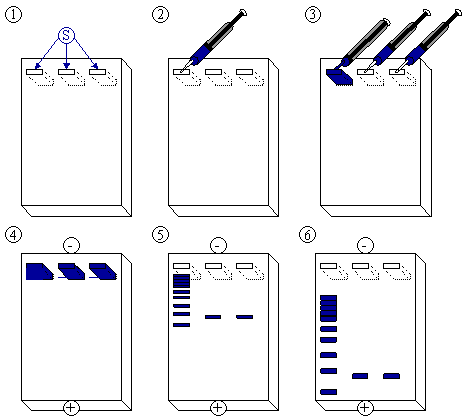 Daily Newsletter
Daily Newsletter
October 23, 2013 - Telomerase & Electrophoresis
Telomerase
The requirement for RNA primers creates a problem at the ends of the DNA molecule, specifically where a strand ends at the 3' (there is a 3' on each strand, remember the strands are antiparallel). When you use this strand for replication, you must first create an RNA primer.
Recall, DNA polymerase has a major requirement. It must have a free 3' end to build (it must have a free 3' -OH group). Consider the drawing below:
The purple line represents the template strand from the parental DNA molecule. We are looking at the 3' end. When we replicate, it must be done in an antiparallel manner; we must synthesize 5'➝ 3'. This leaves the 5' end as RNA. After DNA synthesis is underway, the primer needs to be removed. DNA polymerase δ does this by attaching to an Okazaki fragment and replacing the RNA primer (see image below).
DNA polymerase δ must have a 3' end to work from, so it uses an Okazaki fragment to start. It lacks the ability to bind the 3' to a 5' end (it needs a Triphosphate), so we use ligase to connect the two fragments.
Consider again the end of linear DNA.
There is no 3' end that DNA polymerase δ can begin working to replace the RNA primer. What happens to this end is that you just delete the primer. So, the newly synthesized strand will be shorter. This is a problem! The image below provides a different perspective:
Ultimately, replication will result in degradation of the DNA if this is not fixed. Eukaryotic cells have an enzyme known as Telomerase that can extend the 3' end of DNA with a repetitive sequence of nucleotides. The enzyme contains both RNA and proteins, and is considered a reverse transcriptase. The RNA is a template for the DNA sequence repeat. Vertebrates use the DNA sequence TTAGGG as the repeat, but you should note that the telomere repeat is different for different eukaryotes. For example, most plants use TTTAGGG as the telomere repeat. Here is an image of the process in action:
Gel Electrophoresis
One of the most common analytic techniques for nucleic acids and proteins is Gel Electrophoresis. Electrophoresis deals with the movement of particles through a fluid relative to a uniform electrical field. Remember that all nucleic acids and proteins are charged (remember, they have the ability to hydrogen bond). As a simple explanation, a uniform electric field will have a + side and a - side, so movement in electrophoresis is determined by the electrostatic profile of the molecules.
In gel electrophoresis, the fluid is a semi-solid matrix (i.e., a gel). A very common gel is made from Agarose, which is one of the components of agar, which is used to make solid culture media (the other component is agaropectin). The gel is placed in a buffer solution in a box that has the ability to create an electric field (you will have an anode and cathode). Movement of nucleic acids and proteins will be from - to +. The size and conformation of nucleic acid fragments and protein fragments will determine how far along the gel a fragment will move. Larger fragments move slower.
Because agarose gel can vary in viscosity, a known standard (you know the size and conformation) are always used so that you can get an accurate measurement. You compare the movement of your samples to the known samples in order to determine fragment size. Below is an image showing the gel as it is being loaded with samples (samples go into wells), and how it as it is exposed to an electric field.





No comments:
Post a Comment